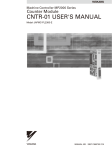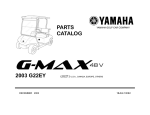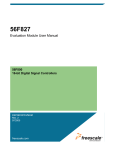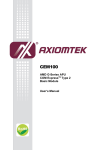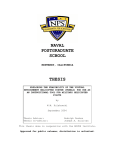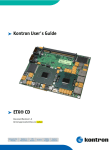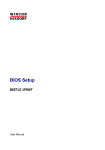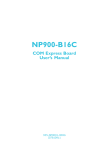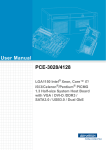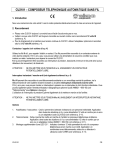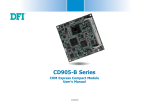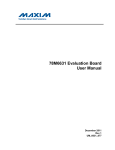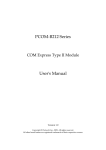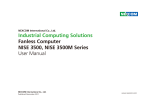Download Manual - DFI Inc.
Transcript
HR900-B COM Express Board User’s Manual A16590443 Copyright This publication contains information that is protected by copyright. No part of it may be reproduced in any form or by any means or used to make any transformation/adaptation without the prior written permission from the copyright holders. This publication is provided for informational purposes only. The manufacturer makes no representations or warranties with respect to the contents or use of this manual and specifically disclaims any express or implied warranties of merchantability or fitness for any particular purpose. The user will assume the entire risk of the use or the results of the use of this document. Further, the manufacturer reserves the right to revise this publication and make changes to its contents at any time, without obligation to notify any person or entity of such revisions or changes. Changes after the publication’s first release will be based on the product’s revision. The website will always provide the most updated information. © 2014. All Rights Reserved. Trademarks Product names or trademarks appearing in this manual are for identification purpose only and are the properties of the respective owners. FCC and DOC Statement on Class B This equipment has been tested and found to comply with the limits for a Class B digital device, pursuant to Part 15 of the FCC rules. These limits are designed to provide reasonable protection against harmful interference when the equipment is operated in a residential installation. This equipment generates, uses and can radiate radio frequency energy and, if not installed and used in accordance with the instruction manual, may cause harmful interference to radio communications. However, there is no guarantee that interference will not occur in a particular installation. If this equipment does cause harmful interference to radio or television reception, which can be determined by turning the equipment off and on, the user is encouraged to try to correct the interference by one or more of the following measures: • • • • Reorient or relocate the receiving antenna. Increase the separation between the equipment and the receiver. Connect the equipment into an outlet on a circuit different from that to which the receiver is connected. Consult the dealer or an experienced radio TV technician for help. Notice: 1. 2. The changes or modifications not expressly approved by the party responsible for compliance could void the user’s authority to operate the equipment. Shielded interface cables must be used in order to comply with the emission limits. 1 Introduction Table of Contents Copyright ........................................................................................... 2 Trademarks ........................................................................................ 2 FCC and DOC Statement on Class B .............................................. 3 About this Manual ............................................................................. 6 Warranty .......................................................................................... 6 Static Electricity Precautions ............................................................. 7 Safety Measures ................................................................................. 7 About the Package ............................................................................ 8 Chapter 1 - Introduction .................................................................. 9 Specifications .................................................................................. 9 Features ...................................................................................... 11 Chapter 2 - Hardware Installation .................................................. 12 Board Layout ................................................................................ 12 Mechanical Diagram ........................................................................................... 13 System Memory ........................................................................... 14 Installing the DIM Module ......................................................... 15 CPU ............................................................................................ 17 Overview................................................................................. 17 Installing the CPU .................................................................... 17 Jumper Settings............................................................................. 19 Clear CMOS Data ..................................................................... 19 Connectors .................................................................................. 20 CPU Fan Connector................................................................... 20 COM Express Connectors .......................................................... 21 PIN Mapping ............................................................................ 26 Standby Power LED ...................................................................... 28 Cooling Option ................................................................................................... 29 Installing HR900-B onto a Carrier Board ........................................ 31 4 Introduction 1 Chapter 3 - BIOS Setup .................................................................. 36 Overview .................................................................................... 36 AMI BIOS Setup Utility ................................................................. 38 Main ....................................................................................... 38 Advanced ................................................................................ 39 Chipset ................................................................................... 49 Boot ....................................................................................... 56 Security .................................................................................. 57 Save&Exit ............................................................................... 58 Updating the BIOS ........................................................................ 59 Notice: BIOS SPI ROM .................................................................. 60 Chapter 4 - Supported Software ................................................... 61 Appendix A - NLITE and AHCI Installation Guide ......................... 85 nLite ....................................................................................................................... 85 AHCI...................................................................................................................... 93 Appendix B - Watchdog Sample Code ........................................... 97 Appendix C - System Error Message.............................................. 98 Appendix D - Troubleshooting ........................................................ 99 5 1 Introduction About this Manual An electronic file of this manual is included in the CD. To view the user’s manual in the CD, insert the CD into a CD-ROM drive. The autorun screen (Main Board Utility CD) will appear. Click “User’s Manual” on the main menu. Warranty 6 1. Warranty does not cover damages or failures that arised from misuse of the product, inability to use the product, unauthorized replacement or alteration of components and product specifications. 2. The warranty is void if the product has been subjected to physical abuse, improper installation, modification, accidents or unauthorized repair of the product. 3. Unless otherwise instructed in this user’s manual, the user may not, under any circumstances, attempt to perform service, adjustments or repairs on the product, whether in or out of warranty. It must be returned to the purchase point, factory or authorized service agency for all such work. 4. We will not be liable for any indirect, special, incidental or consequencial damages to the product that has been modified or altered. Introduction 1 Static Electricity Precautions It is quite easy to inadvertently damage your PC, system board, components or devices even before installing them in your system unit. Static electrical discharge can damage computer components without causing any signs of physical damage. You must take extra care in handling them to ensure against electrostatic build-up. 1. To prevent electrostatic build-up, leave the system board in its anti-static bag until you are ready to install it. 2. Wear an antistatic wrist strap. 3. Do all preparation work on a static-free surface. 4. Hold the device only by its edges. Be careful not to touch any of the components, contacts or connections. 5. Avoid touching the pins or contacts on all modules and connectors. Hold modules or connectors by their ends. Important: Electrostatic discharge (ESD) can damage your processor, disk drive and other components. Perform the upgrade instruction procedures described at an ESD workstation only. If such a station is not available, you can provide some ESD protection by wearing an antistatic wrist strap and attaching it to a metal part of the system chassis. If a wrist strap is unavailable, establish and maintain contact with the system chassis throughout any procedures requiring ESD protection. Safety Measures To avoid damage to the system: • Use the correct AC input voltage range. To reduce the risk of electric shock: • Unplug the power cord before removing the system chassis cover for installation or servicing. After installation or servicing, cover the system chassis before plugging the power cord. 7 1 Introduction About the Package The package contains the following items. If any of these items are missing or damaged, please contact your dealer or sales representative for assistance. One HR900-B board One drivers/utilities disk One QR (Quick Reference) The board and accessories in the package may not come similar to the information listed above. This may differ in accordance with the sales region or models in which it was sold. For more information about the standard package in your region, please contact your dealer or sales representative. Optional Items COM630-B carrier board kit Heat spreader Heat sink with fan Heat spreader with heat sink and fan The system board and accessories in the package may not come similar to the information listed above. This may differ in accordance to the sales region or models in which it was sold. For more information about the standard package in your region, please contact your dealer or sales representative. Before Using the System Board Before using the system board, prepare basic system components. If you are installing the system board in a new system, you will need at least the following internal components. • • Memory module Storage devices such as hard disk drive, CD-ROM, etc. You will also need external system peripherals you intend to use which will normally include at least a keyboard, a mouse and a video display monitor. 8 Introduction 1 Chapter 1 - Introduction Specifications Processor • Socket G2 988B for: - 3rd Generation Intel® CoreTM processors (22nm process technology) : Intel® Core™ i7-3610QE (6M Cache, up to 3.3 GHz); 45W : Intel® Core™ i5-3610ME (3M Cache, up to 3.3 GHz); 35W : Intel® Core™ i3-3120ME (3M Cache, 2.4 GHz); 35W - 2nd Generation Intel® CoreTM processors (32nm process technology) : Intel® Core™ i7-2710QE (6M Cache, up to 3.0 GHz); 45W : Intel® Core™ i5-2510E (3M Cache, up to 3.1 GHz); 35W : Intel® Core™ i3-2330E (3M Cache, 2.2 GHz); 35W : Intel® Celeron® B810 (2M Cache, 1.6 GHz); 35W • Intel® Advanced Vector Extensions (Intel® AVX) Instructions • Intel® Turbo Boost Technology Chipset • Intel® QM67 Express Chipset System Memory • Two 204-pin DDR3 SODIMM sockets 3rd Generation Processors DDR3 1066/1333/1600MHz 2nd Generation Processors DDR3 1066/1333MHz (i5/i3/Celeron) DDR3 1600MHz (i7) • Supports dual channel memory interface • Supports up to 16GB system memory • DRAM device technologies: 1Gb, 2Gb and 4Gb DDR3 DRAM technologies are supported for x8 and x16 devices, unbuffered, non-ECC Graphics • • • • • • Audio • Supports High Definition Audio interface Intel® HD Graphics 4000 (3rd generation processors) Intel® HD Graphics 3000 (2nd generation processors) Intel® HD Graphics (Intel® Celeron® processors) Supports VGA, LVDS and DDI interfaces VGA: resolution up to 2048x1536 @ 75Hz LVDS: Single Channel - 18/24-bit; Dual Channel - 36/48-bit, resolution up to 1920x1200 @ 60Hz • Digital Display Interfaces: HDMI, DP and SDVO (for Port B) • HDMI, DP: resolution up to 1920x1200 @ 60Hz • Supports 6 or 16 Graphics Execution Units (EUs) (3rd generation processors) • Supports 6 or 12 Graphics Execution Units (EUs) (2nd generation processors) • Intel® Clear Video Technology • DirectX Video Acceleration (DXVA) support for accelerating video processing • Supports DirectX 11/10.1/10/9 and OpenGL 3.0 (3rd generation processors) • Supports DirectX 10.1/10/9 and OpenGL 3.0 (2nd generation processors) 9 1 Introduction LAN • Intel 82579LM Gigabit Ethernet PHY • Integrated 10/100/1000 transceiver • Fully compliant with IEEE 802.3, IEEE 802.3u, IEEE 802.3ab SATA • Supports 4 Serial ATA interfaces • 2 SATA 2.0 with data transfer rate up to 3Gb/s • 2 SATA 3.0 with data transfer rate up to 6Gb/s • Integrated Advanced Host Controller Interface (AHCI) controller IDE • Supports up to two IDE devices • DMA mode: Ultra ATA up to 100MB/s • PIO mode: up to 16MB/s Expansion • Supports 8 USB ports (USB 1.1/2.0 host controllers) • Supports 4 PCI slots (PCI 2.3 interface) • Supports PCIe x16/SDVO/HDMI/Display Port switchable interface - Uses QM67's DDI (Digital Display Interface) Port B for SDVO/HDMI and DDI Port C for Display Port/HDMI - VBIOS default setting at Port C only; VBIOS settings modified upon request • Supports 1 PCIE x16 interface - Supports Gen 3.0 (3rd generation processors) - Supports Gen 2.0 (2nd generation processors) • Supports 5 PCIE x1 interfaces • Supports LPC interface • Supports SMBus interface • Supports IDE interface • Supports 8-bit Digital I/O Interfaces 10 Damage Free Intelligence • Monitors CPU temperature and overheat alarm • Monitors CPU fan speed and failure alarm • Monitors Vcore/VGFX/1.5V voltages and failure alarm • Watchdog timer function BIOS • 64Mbit UEFI SPI BIOS Power Consumption • 54.70 W with i7-2710QE at 2.10GHz and 2x 4GB DDR3 SODIMM OS Support • • • • • • Temperature • 0oC to 60oC Humidity • 10% to 90% Power • Input: 12V, 5VSB (optional), VCC_RTC Certification • CE, FCC Class B, UL, RoHS PCB • Dimensions - Basic COM Express form factor - 95mm (3.74”) x 125mm (4.9”) • Compliance - PICMG COM Express R1.0 basic form factor, Type 2 Windows Windows Windows Windows Windows Windows XP Professional x86 & SP3 (32-bit) XP Professional x64 & SP2 (64-bit) 7 Ultimate x86 & SP1 (32-bit) 7 Ultimate x64 & SP1 (64-bit) 8 Enterprise x86 (32-bit) 8 Enterprise x64 (64-bit) Introduction 1 Features Watchdog Timer The Watchdog Timer function allows your application to regularly “clear” the system at the set time interval. If the system hangs or fails to function, it will reset at the set time interval so that your system will continue to operate. DDR3 DDR3 delivers increased system bandwidth and improved performance. The advantages of DDR3 are its higher bandwidth and its increase in performance at a lower power than DDR2. Graphics The integrated Intel® HD graphics engine delivers an excellent blend of graphics performance and features to meet business needs. It provides excellent video and 3D graphics with outstanding graphics responsiveness. These enhancements deliver the performance and compatibility needed for today’s and tomorrow’s business applications. Supports LVDS, VGA and DDI interfaces for display outputs. Serial ATA Serial ATA is a storage interface that is compliant with SATA 1.0a specification. With speed of up to 3Gb/s (SATA 2.0) and 6Gb/s (SATA 3.0), it improves hard drive performance faster than the standard parallel ATA whose data transfer rate is 100MB/s. The bandwidth of the SATA 3.0 will be limited by carrier board design. Gigabit LAN The Intel 82579LM Gigabit LAN controller supports up to 1Gbps data transmission. 11 2 Hardware Installation Chapter 2 - Hardware Installation Board Layout Intel QM67 CPU fan Clear CMOS (JP1) SPI Flash BIOS Intel 82579LM Standby Power LED Top View D1 D110 COM Express connector C1 C110 B1 B110 COM Express connector A1 A110 Buttom View 12 DDR3_2 SODIMM 1 DDR3_1 SODIMM Socket G2 rPGA 988B 1 Hardware Installation 2 Mechanical Diagram 121.00 117.00 87.00 0.00 4.00 91.00 87.00 95.00 91.00 87.00 Top View 1 0.00 4.00 0.00 4.00 125.00 121.00 117.00 76.00 0.00 4.00 Ø2.70(*6 pcs) Bottom View 14.00 2.00 0.00 0.00 12.50 70.20 13 2 Hardware Installation Important: Electrostatic discharge (ESD) can damage your board, processor, disk drives, add-in boards, and other components. Perform installation procedures at an ESD workstation only. If such a station is not available, you can provide some ESD protection by wearing an antistatic wrist strap and attaching it to a metal part of the system chassis. If a wrist strap is unavailable, establish and maintain contact with the system chassis throughout any procedures requiring ESD protection. System Memory The system board is equipped with two 204-pin SODIMM sockets that support DDR3 memory modules. Important: When the Standby Power LED lit red, it indicates that there is power on the board. Power-off the PC then unplug the power cord prior to installing any devices. Failure to do so will cause severe damage to the board and components. DDR3_2 DDR3_1 Standby Power LED 14 Hardware Installation 2 Installing the DIM Module Note: The system board used in the following illustrations may not resemble the actual one. These illustrations are for reference only. 1. Make sure the PC and all other peripheral devices connected to it has been powered down. 2. Disconnect all power cords and cables. 3. Locate the SODIMM socket on the system board. 4. Note the key on the socket. The key ensures the module can be plugged into the socket in only one direction. 15 2 Hardware Installation 5. Grasping the module by its edges, align the module into the socket at an approximately 30 degrees angle. Apply firm even pressure to each end of the module until it slips down into the socket. The contact fingers on the edge of the module will almost completely disappear inside the socket. 6. Push down the module until the clips at each end of the socket lock into position. You will hear a distinctive “click”, indicating the module is correctly locked into position. Clip 16 Clip Hardware Installation 2 CPU Overview The system board is equipped with a surface mount rPGA 988B CPU socket. Note: The system board used in the following illustrations may not resemble the actual one. These illustrations are for reference only. Installing the CPU 1. Make sure the PC and all other peripheral devices connected to it has been powered down. 2. Disconnect all power cords and cables. 3. Locate the rPGA 988B socket on the board. 4. Make sure the screw is in its unlock position. If it’s not, use a screwdriver to turn the screw to its unlock position. Screw in unlocked position 17 2 Hardware Installation 5. Position the CPU above the socket. The gold triangular mark on the CPU must align with pin 1 of the CPU socket. Important: Handle the CPU by its edges and avoid touching the pins. 6. Insert the CPU into the socket until it is seated in place. The CPU will fit in only one orientation and can easily be inserted without exerting any force. Use a screwdriver to turn the screw to its lock position. Important: Do not force the CPU into the socket. Forcing the CPU into the socket may bend the pins and damage the CPU. 18 Gold triangular mark Pin 1 Screw in locked position Hardware Installation 2 Jumper Settings Clear CMOS Data 3 3 2 1 2 1 1-2 On: Normal (default) JP1 2-3 On: Clear CMOS Data If you encounter the following, a) CMOS data becomes corrupted. b) You forgot the supervisor or user password. you can reconfigure the system with the default values stored in the ROM BIOS. To load the default values stored in the ROM BIOS, please follow the steps below. 1. Power-off the system and unplug the power cord. 2. Set pins 2 and 3 to On. Wait for a few seconds and set the jumper back to its default setting, pins 1 and 2 On. 3. Now plug the power cord and power-on the system. 19 2 Hardware Installation Connectors CPU Fan Connector Sense Power Ground 1 3 Connect the CPU fan’s cable connector to the CPU fan connector on the board. The cooling fan will provide adequate airflow throughout the chassis to prevent overheating the CPU and board components. BIOS Setting “Module Board H/W Monitor” submenu in the Advanced menu of the BIOS will display the current speed of the cooling fan. Refer to chapter 3 of the manual for more information. 20 Hardware Installation 2 COM Express Connectors The COM Express connectors are used to interface the HR900-B COM Express board to a carrier board. Connect the COM Express connectors (lcoated on the solder side of the board) to the COM Express connectors on the carrier board. Refer to the “Installing HR900-B onto a Carrier Board” section for more information. COM Express Connectors Refer to the following pages for the pin functions of these connectors. 21 2 Hardware Installation 1 2 3 4 5 6 7 8 9 10 11 12 13 14 15 16 17 18 19 20 21 22 23 24 25 26 27 28 29 30 31 32 33 34 35 36 37 38 39 40 41 42 43 44 45 46 47 48 49 50 51 52 53 54 55 22 Row GNDA1 GBE0_MDI3GBE0_MDI3+ GNE0_LINK100# GBE0_LINK1000# GBE0_MDI2GBE0_MDI2+ NC GBE0_MDI1GBE0_MDI1+ GNDA2 GBE0_MDI0GBE0_MDI0+ GBE0_CTREF SUS_S3# SATA0_TX+ SATA0_TXSUS_S4# SATA0_RX+ SATA0_RXGNDA3 SATA4_TX+ SATA4_TXSUS_S5# SATA4_RX+ SATA4_RXBATLOW# ATA_ACT# AC_SYNC AC_RST# GNDA4 AC_BITCLK AC_SDOUT NC THRMTRIP# USB10USB10+ USB8_10_OC# USB8USB8+ GNDA5 USB2USB2+ USB0_3_OC# USB0USB0+ VCC_RTC PCH GPIO68 PCH GPIO70 LPC_SERIRQ GNDA6 NC NC GPI0(PCH GPIO2) PCIE_TX8+ A 56 57 58 59 60 61 62 63 64 65 66 67 68 69 70 71 72 73 74 75 76 77 78 79 80 81 82 83 84 85 86 87 88 89 90 91 92 93 94 95 96 97 98 99 100 101 102 103 104 105 106 107 108 109 110 PCIE_TX8GBD PCIE_TX4+ PCIE_TX4GNDA7 PCIE_TX3+ PCIE_TX3GPI1(PCH GPIO3) PCIE_TX2+ PCIE_TX2GNDA8 GPI2(PCH GPIO4) PCIE_TX1+ PCIE_TX1GNDA9 LVDS_A0+ LVDS_A0LVDS_A1+ LVDS_A1LVDS_A2+ LVDS_A2LVDS_VDD_EN LVDS_A3+ LVDS_A3GNDA10 LVDS_A_CK+ LVDS_A_CKLVDS_I2C_CK LVDS_I2C_DAT GPI3(PCH GPIO5) KBD_RST# KBD_A20GATE PCIE0_CK_REF+ PCIE1_CK_REFGNDA11 RSVDA1 NC GPO0(PCH GPIO52) NC NC GNDA12 VCC_12VA1 VCC_12VA2 VCC_12VA3 GNDA13 VCC_12VA4 VCC_12VA5 VCC_12VA6 VCC_12VA7 VCC_12VA8 VCC_12VA9 VCC_12VA10 VCC_12VA11 VCC_12VA12 GNDA14 Hardware Installation 1 2 3 4 5 6 7 8 9 10 11 12 13 14 15 16 17 18 19 20 21 22 23 24 25 26 27 28 29 30 31 32 33 34 35 36 37 38 39 40 41 42 43 44 45 46 47 48 49 50 51 52 53 54 55 Row GNDB1 GBE0_ACT# LPC_FRAME# LPC_AD0 LPC_AD1 LPC_AD2 LPC_AD3 LPC_DRQ0# LPC_DRQ1# LPC_CLK GNDB2 PWRBTN# SMB_CK SMB_DAT SMB_ALERT# SATA1_TX+ SATA1_TXSUS_STAT# SATA1_RX+ SATA1_RXGNDB3 SATA5_TX+ SATA5_TXPWR_OK SATA5_RX+ SATA5_RXWDT AC_SDIN2 AC_SDIN1 AC_SDIN0 GNDB4 SPKR I2C_CK I2C_DAT THRM# USB11USB11+ USB8_11_OC# USB9USB9+ GNDB5 USB3USB3+ USB0_3_OC# USB1USB1+ PCH_GPIO69 PCH_GPIO71 SYS_RESET# CB_RESET# GNDB6 NC NC GPO1(PCH GPIO53) PCIE_RX8+ B 56 57 58 59 60 61 62 63 64 65 66 67 68 69 70 71 72 73 74 75 76 77 78 79 80 81 82 83 84 85 86 87 88 89 90 91 92 93 94 95 96 97 98 99 100 101 102 103 104 105 106 107 108 109 110 2 PCIE_RX8GPO2(PCH GPIO54) PCIE_RX4+ PCIE_RX4GNDB7 PCIE_RX3+ PCIE_RX3GPO3(PCH GPIO55) PCIE_RX2+ PCIE_RX2WAKE0# WAKE1# PCIE_RX1+ PCIE_RX1GNDB8 LVDS_B0+ LVDS_B0LVDS_B1+ LVDS_B1LVDS_B2+ LVDS_B2LVDS_B3+ LVDS_B3LVDS_BKLT_EN GNDB9 LVDS_B_CK+ LVDS_B_CKLVDS_BKLT_CTRL VCC_5V_SBYB1 VCC_5V_SBYB2 VCC_5V_SBYB3 VCC_5V_SBYB4 NC VGA_RED GNDB10 VGA_GREEN VGA_BLUE VGA_HSYNC VGA_VSYNC VGA_I2C_CK VGA_I2C_DAT NC NC NC GNDB11 VCC_12VB1 VCC_12VB2 VCC_12VB3 VCC_12VB4 VCC_12VB5 VCC_12VB6 VCC_12VB7 VCC_12VB8 VCC_12VB9 GNDB12 23 2 Hardware Installation 1 2 3 4 5 6 7 8 9 10 11 12 13 14 15 16 17 18 19 20 21 22 23 24 25 26 27 28 29 30 31 32 33 34 35 36 37 38 39 40 41 42 43 44 45 46 47 48 49 50 51 52 53 54 55 24 Row C GNDC1 56 IDE_D7 57 IDE_D6 58 IDE_D3 59 IDE_D15 60 IDE_D8 61 IDE_D9 62 IDE_D2 63 IDE_D13 64 IDE_D1 65 GNDC2 66 IDE_D14 67 IDE_IORDY 68 IDE_IOR# 69 PCI_PME# 70 PCI_GNT2# 71 PCI_REQ2# 72 PCI_GNT1# 73 74 PCI_REQ1# PCI_GNT0# 75 GNDC3 76 PCI_REQ0# 77 PCI_RESET# 78 PCI_AD0 79 PCI_AD2 80 PCI_AD4 81 PCI_AD6 82 PCI_AD8 83 PCI_AD10 84 PCI_AD12 85 GNDC4 86 PCI_AD14 87 PCI_C/BE1# 88 PCI_PERR# 89 PCI_LOCK# 90 PCI_DEVSEL# 91 PCI_IRDY# 92 PCI_C/BE2# 93 PCI_AD17 94 PCI_AD19 95 GNDC5 96 PCI_AD21 97 PCI_AD23 98 PCI_C/BE3# 99 PCI_AD25 100 PCI_AD27 101 PCI_AD29 102 PCI_AD31 103 104 PCI_IRQA# PCI_IRQB# 105 GNDC6 106 PEG_RX0+/SDVO_TVCLK+ 107 PEG_RX0-/SDVO_TVCLK108 NC 109 PEG_RX1+/SDVO_INT+ 110 PEG_RX1-/SDVO_INTNC PEG_RX2+/SDVO_STALL+ PEG_RX2-/SDVO_STALLGNDC7 PEG_RX3+/DDPB_HPD PEG_RX3NC NC PEG_RX4+ PEG_RX4NC PEG_RX5+ PEG_RX5GNDC8 PEG_RX6+/DDPC_AUX+ PEG_RX6-/DDPC_AUXSDVOB_CTRLDATA PEG_RX7+/DDPC_HPD PEG_RX7GNDC9 NC PEG_RX8+ PEG_RX8GNDC10 PEG_RX9+ PEG_RX9NC/DDPC_CTRLDATA GNDC11 PEG_RX10+ PEG_RX10GNDC12 PEG_RX11+ PEG_RX11GNDC13 PEG_RX12+ PEG_RX12GNDC14 PEG_RX13+ PEG_RX13GNDC15 NC PEG_RX14+ PEG_RX14GNDC16 PEG_RX15+ PEG_RX15GNDC17 VCC_12VC1 VCC_12VC2 VCC_12VC3 VCC_12VC4 VCC_12VC5 VCC_12VC6 GNDC18 Hardware Installation 1 2 3 4 5 6 7 8 9 10 11 12 13 14 15 16 17 18 19 20 21 22 23 24 25 26 27 28 29 30 31 32 33 34 35 36 37 38 39 40 41 42 43 44 45 46 47 48 49 50 51 52 53 54 55 GNDD1 IDE_D5 IDE_D10 IDE_D11 IDE_D12 IDE_D4 IDE_D0 IDE_REQ# IDE_IOW# IDE_ACK# GNDD2 IDE_IRQ IDE_A0 IDE_A1 IDE_A2 IDE_CS1# IDE_CS3# IDE_RESET# PCI_GNT3# PCI_REQ3# GNDD3 PCI_AD1 PCI_AD3 PCI_AD5 PCI_AD7 PCI_C/BE0# PCI_AD9 PCI_AD11 PCI_AD13 PCI_AD15 GNDD4 PCI_PAR PCI_SERR# PCI_STOP# PCI_TRDY# PCI_FRAME# PCI_AD16 PCI_AD18 PCI_AD20 PCI_AD22 GNDD5 PCI_AD24 PCI_AD26 PCI_AD28 PCI_AD30 PCI_IRQC# PCI_IRQD# PCI_CLKRUN# NC PCI_CLK GNDD6 PEG_TX0+/DDPB_0+ PEG_TX0-/DDPB_0NC PEG_TX1+/DDPB_1+ Row D 56 57 58 59 60 61 62 63 64 65 66 67 68 69 70 71 72 73 74 75 76 77 78 79 80 81 82 83 84 85 86 87 88 89 90 91 92 93 94 95 96 97 98 99 100 101 102 103 104 105 106 107 108 109 110 2 PEG_TX1-/DDPB_1NC PEG_TX2+/DDPB_2+ PEG_TX2-/DDPB_2GNDD7 PEG_TX3+/DDPB_3+ PEG_TX3-/DDPB_3NC NC PEG_TX4+/DDPC_0+ PEG_TX4-/DDPC_0GNDD8 PEG_TX5+/DDPC_1+ PEG_TX5-/DDPC_1GNDD9 PEG_TX6+/DDPC_2+ PEG_TX6-/DDPC_2SDVO_CLK PEG_TX7+/DDPC_3+ PEG_TX7-/DDPC_3GNDD10 IDE_CBLID# PEG_TX8+ PEG_TX8GNDD11 PEG_TX9+ PEG_TX9NC/DDPC_CTRLCLK GNDD12 PEG_TX10+ PEG_TX10GNDD13 PEG_TX11+ PEG_TX11GNDD14 PEG_TX12+ PEG_TX12GNDD15 PEG_TX13+ PEG_TX13GNDD16 NC PEG_TX14+ PEG_TX14GNDD17 PEG_TX15+ PEG_TX15GNDD18 VCC_12VD1 VCC_12VD2 VCC_12VD3 VCC_12VD4 VCC_12VD5 VCC_12VD6 GNDD19 25 2 Hardware Installation PIN Mapping DDI Port B COM Express BTB Connector Pin No. ! 26 QM67 Digital Display Interface Signal (Port B) SDVO HDMI/DVI D52 D53 D55 DDPB_[0]P: red DDPB_[0]P: TMDSB_DATA2 DDPB_[0]N: red complement DDPB_[0]N: TMDSB_DATA2B DDPB_[1]P: green DDPB_[1]P: TMDSB_DATA1 D56 D58 D59 D61 D62 DDPB_[1]N:green complement DDPB_[1]N: TMDSB_DATA1B DDPB_[2]P: blue DDPB_[2]P: TMDSB_DATA0 DDPB_[2]N: blue complement DDPB_[2]N: TMDSB_DATA0B DDPB_[3]P: clock DDPB_[3]P: TMDSB_CLK DDPB_[3]N: clock complement DDPB_[3]N: TMDSB_CLKB C52 C53 SDVO_TVCLKINP C55 C56 C58 C59 C61 C73 D73 SDVO_INTP SDVO_TVCLKINN SDVO_INTN SDVO_STALLP SDVO_STALLN DDPB_HPD SDVO_CTRLDATA HDMI Control Data. SDVO_CTRLCLK HDMI Control Clock Hardware Installation 2 DDI Port C COM Express BTB Connector Pin No. QM67 Digital Display Interface Signal (Port C) Display Port HDMI/DVI D65 D66 D68 DDPC_[0]P: Display Port Lane 0 DDPC_[0]P: TMDSC_DATA2 DDPC_[0]N: Lane 0 complement DDPC_[0]N: TMDSC_DATA2B DDPC_[1]P: Display Port Lane 1 DDPC_[1]P: TMDSC_DATA1 D69 D71 D72 D74 D75 DDPC_[1]N: Lane 1 complement DDPC_[1]N: TMDSC_DATA1B DDPC_[2]P: Display Port Lane 2 DDPC_[2]P: TMDSC_DATA0 DDPC_[2]N: Lane 2 complement DDPC_[2]N: TMDSC_DATA0B DDPC_[3]P: Display Port Lane 3 DDPC_[3]P: TMDSC_CLK DDPC_[3]N: Lane 3 complement DDPC_[3]N: TMDSC_CLKB C71 DDPC_AUX_P C72 DDPC_AUX_N C74 C83 D83 DDPC_HPD DDPC_HPD SDVO_CTRLDATA HDMI Control Data. SDVO_CTRLCLK HDMI Control Clock ! 27 2 Hardware Installation Standby Power LED Standby Power LED This LED will light when the system is in the standby mode. 28 Hardware Installation 2 Cooling Option Heat Sink with Cooling Fan Top View of the Heat Sink 1 Bottom View of the Heat Sink 2 • “1” and “2” denote the locations of the thermal pads designed to contact the corresponding components that are on HR900-B. • Remove the plastic covering from the thermal pads prior to mounting the heat sink onto HR900-B. 29 2 Hardware Installation Dimensions 95.00 87.00 4.00 95.00 87.00 34.60 1 4.00 76.00 4.00 34.60 24.60 Cooler Module PCB The height of the highest parts 8.00 2.00 3.50 1.60 30 Module PCB Standoff Carrier Board Hardware Installation 2 Installing HR900-B onto a Carrier Board Important: The carrier board used in this section is for reference purpose only and may not resemble your carrier board. These illustrations are mainly to guide you on how to install HR900-B onto the carrier board of your choice. 1. The photo below shows the locations of the mounting holes. Mounting hole 2. Insert the provided mounting screws into the mounting holes - from the bottom through the top of the carrier board. Mounting screws 31 2 Hardware Installation 3. While supporting the mounting screw at the bottom, from the top side of the board, fasten a bolt into the screw. Bolts 4. The photo below shows the solder side of the board with the screws already fixed in place. Mounting screw 32 Hardware Installation 5. 2 The photo below shows the component side of the board with the bolts already fixed in place. Bolts 6. Position the heat sink on top of HR900-B with the heat sink’s mounting holes aligned with HR900-B’s mounting holes. Insert one of the provided long screws into the mounting hole shown in the photo below. Mounting hole Long screw 33 2 Hardware Installation 7. From the bottom of the board, fasten the provided bolt into the screw and then connect the cooling fan’s cable to the fan connector on HR900-B. Fan connector Bolt 8. Grasping HR900-B by its edges, position it on top of the carrier board with its mounting holes aligned with the bolts on the carrier board. This will also align the COM Express connectors of the two boards to each other. COM Express connectors on HR900-B COM Express connectors on the carrier board 34 Hardware Installation 9. 2 Press HR900-B down firmly until it is completely seated on the COM Express connectors of the carrier board. HR900-B Carrier board 10. Use the provided mounting screws to secure HR900-B with heat sink to the carrier board. The photo below shows the locations of the long/short mounting screws. Long screws Short screws 35 3 BIOS Setup Chapter 3 - BIOS Setup Overview The BIOS is a program that takes care of the basic level of communication between the CPU and peripherals. It contains codes for various advanced features found in this system board. The BIOS allows you to configure the system and save the configuration in a battery-backed CMOS so that the data retains even when the power is off. In general, the information stored in the CMOS RAM of the EEPROM will stay unchanged unless a configuration change has been made such as a hard drive replaced or a device added. It is possible that the CMOS battery will fail causing CMOS data loss. If this happens, you need to install a new CMOS battery and reconfigure the BIOS settings. Note: The BIOS is constantly updated to improve the performance of the system board; therefore the BIOS screens in this chapter may not appear the same as the actual one. These screens are for reference purpose only. Default Configuration Most of the configuration settings are either predefined according to the Load Optimal Defaults settings which are stored in the BIOS or are automatically detected and configured without requiring any actions. There are a few settings that you may need to change depending on your system configuration. Entering the BIOS Setup Utility The BIOS Setup Utility can only be operated from the keyboard and all commands are keyboard commands. The commands are available at the right side of each setup screen. The BIOS Setup Utility does not require an operating system to run. After you power up the system, the BIOS message appears on the screen and the memory count begins. After the memory test, the message “Press DEL to run setup” will appear on the screen. If the message disappears before you respond, restart the system or press the “Reset” button. You may also restart the system by pressing the <Ctrl> <Alt> and <Del> keys simultaneously. 36 BIOS Setup 3 Legends Keys Function Right and Left arrows Moves the highlight left or right to select a menu. Up and Down arrows Moves the highlight up or down between submenus or fields. <Esc> Exits to the BIOS Setup Utility. + (plus key) Scrolls forward through the values or options of the highlighted field. - (minus key) Scrolls backward through the values or options of the highlighted field. Tab Selects a field. <F1> Displays General Help. <F4> Saves and exits the Setup program. <Enter> Press <Enter> to enter the highlighted submenu. Scroll Bar When a scroll bar appears to the right of the setup screen, it indicates that there are more available fields not shown on the screen. Use the up and down arrow keys to scroll through all the available fields. Submenu When ““ appears on the left of a particular field, it indicates that a submenu which contains additional options are available for that field. To display the submenu, move the highlight to that field and press <Enter>. 37 3 BIOS Setup AMI BIOS Setup Utility Main The Main menu is the first screen that you will see when you enter the BIOS Setup Utility. Main Aptio Setup Utility - Copyright (C) 2011 American Megatrends, Inc. Advanced Boot Security Save & Exit Chipset BIOS Information BIOS Vendor Core Version Compliancy Project Version Build Date and Time American Megatrends 4.6.5.3 UEFI 2.3; PI 1.2 1APTJ 0.18 x64 02/01/2013 17:32:35 System Date System Time [Thu 01/01/2009] [06:39:22] Access Level Administrator Set the Date. Use Tab to switch between Date elements. Select Screen Select Item Enter: Select +/-: Change Opt. F1: General Help F2: Previous Values F3: Optimized Defaults ESC: Exit Version 2.14.1219. Copyright (C) 2011 American Megatrends, Inc. System Date The date format is <day>, <month>, <date>, <year>. Day displays a day, from Sunday to Saturday. Month displays the month, from January to December. Date displays the date, from 1 to 31. Year displays the year, from 1980 to 2099. System Time The time format is <hour>, <minute>, <second>. The time is based on the 24hour military-time clock. For example, 1 p.m. is 13:00:00. Hour displays hours from 00 to 23. Minute displays minutes from 00 to 59. Second displays seconds from 00 to 59. 38 BIOS Setup 3 Advanced The Advanced menu allows you to configure your system for basic operation. Some entries are defaults required by the system board, while others, if enabled, will improve the performance of your system or let you set some features according to your preference. Important: Setting incorrect field values may cause the system to malfunction. Aptio Setup Utility - Copyright (C) 2011 American Megatrends, Inc. Main Advanced Chipset Boot ACPI Settings CPU Configuration Save & Exit System ACPI Parameters SATA Configuration Intel TXT(LT) Configuration PCH-FW Configuration Intel(R) Anti-Theft Technology USB Configuration F75387 Module Board Security Configuration H/W Monitor Onboard ATA Controller Configuration WatchDog Configuration Network Stack CPU PPM Configuration Select Screen Select Item Enter: Select +/-: Change Opt. F1: General Help F2: Previous Values F3: Optimized Defaults ESC: Exit Version 2.14.1219. Copyright (C) 2011 American Megatrends, Inc. Launch PXE OpROM Enables or disables the boot option for legacy network devices. Launch Storage OpROM Enables or disables the boot option for legacy mass storage devices with option ROM. 39 3 BIOS Setup ACPI Settings This section is used to configure the ACPI settings. Aptio Setup Utility - Copyright (C) 2011 American Megatrends, Inc. Advanced Enables or Disables BIOS ACPI Auto Configuration. ACPI Settings Enable ACPI Auto Configuration [Disabled] ACPI Sleep State [S3 (Suspend to RAM) ] Resume by PME Resume by RTC Alarm [Disabled] [Disabled] Select Screen Select Item Enter: Select +/-: Change Opt. F1: General Help F2: Previous Values F3: Optimized Defaults ESC: Exit Version 2.14.1219. Copyright (C) 2011 American Megatrends, Inc. ACPI Sleep State Selects the highest ACPI sleep state the system will enter when the Suspend button is pressed. S1(POS) Enables the Power On Suspend function. S3(STR) Enables the Suspend to RAM function. Resume by PME Enable this field to use the PME signal to wake up the system (via PCI, PCIE, onboard LAN and PS2 KB/MB). Resume by RTC Alarm When Enabled, the system uses the RTC to generate a wakeup event. 40 BIOS Setup 3 CPU Configuration This section is used to configure the CPU. It will also display the detected CPU information. Aptio Setup Utility - Copyright (C) 2011 American Megatrends, Inc. Advanced CPU Configuration Intel (R) Core (TM) i7-2710QE CPU @ 2.10GHz Supported EMT64 2100 MHz Processor Speed 206a7 Processor Stepping d Microcode Revision 4 Processor Cores Supported Intel HT Technology Hyper-threading Limit CUPID Maximum Intel Virtualization Technology [Enabled] [Disabled] [Disabled] Enabled for Windows XP and Linux (OS optimized for Hyper-Threading Technology) and Disabled for other OS (OS not optimized for Hyper-Threading Technology). When Disabled only one thread per enabled core is enabled. Select Screen Select Item Enter: Select +/-: Change Opt. F1: General Help F2: Previous Values F3: Optimized Defaults ESC: Exit Version 2.14.1219. Copyright (C) 2011 American Megatrends, Inc. Hyper-threading Enable this field for Windows XP and Linux which are optimized for HyperThreading technology. Select disabled for other OSes not optimized for HyperThreading technology. When disabled, only one thread per enabled core is enabled. Limit CUPID Maximum The CPUID instruction of some newer CPUs will return a value greater than 3. The default is Disabled because this problem does not exist in the Windows series operating systems. If you are using an operating system other than Windows, this problem may occur. To avoid this problem, enable this field to limit the return value to 3 or less than 3. Intel Virtualization Technology When this field is set to Enabled, the VMM can utilize the additional hardware capabilities provided by Vanderpool Technology. 41 3 BIOS Setup SATA Configuration This section is used to configure SATA functions. Aptio Setup Utility - Copyright (C) 2011 American Megatrends, Inc. Advanced SATA Controller(s) SATA Mode Selection [Enabled] [IDE] Serial ATA Port 0 Software Preserve Serial ATA Port 1 Software Preserve Serial ATA Port 4 Software Preserve Serial ATA Port 5 Software Preserve Empty Unknown Empty Unknown Empty Unknown Empty Unknown Enable or disable SATA Device. Select Screen Select Item Enter: Select +/-: Change Opt. F1: General Help F2: Previous Values F3: Optimized Defaults ESC: Exit Version 2.14.1219. Copyright (C) 2011 American Megatrends, Inc. SATA Controller(s) This field is used to enable or disable the Serial ATA channels. SATA Mode Selection IDE Mode This option configures the Serial ATA drives as Parallel ATA storage devices. AHCI Mode This option allows the Serial ATA devices to use AHCI (Advanced Host Controller Interface). 42 BIOS Setup 3 PCH-FW Configuration Aptio Setup Utility - Copyright (C) 2011 American Megatrends, Inc. Advanced ME FW Version ME Firmware Mode ME Firmware Type ME Firmware SKU Firmware Update Configuration 8.0.3.1427 Normal Mode Full Sku Firmware 5MB Select Screen Select Item Enter: Select +/-: Change Opt. F1: General Help F2: Previous Values F3: Optimized Defaults ESC: Exit Version 2.14.1219. Copyright (C) 2011 American Megatrends, Inc. Anti-Theft Configuration This section is used to disable the PC at the hardware level in the event of loss or theft. Aptio Setup Utility - Copyright (C) 2011 American Megatrends, Inc. Advanced Enable/Disable AT in BIOS for testing only. Intel Anti-Theft Configuration Anti-Theft Anti-Theft Recovery Enter AT Suspend Mode [Disabled] 3 [Disabled] Select Screen Select Item Enter: Select +/-: Change Opt. F1: General Help F2: Previous Values F3: Optimized Defaults ESC: Exit Version 2.14.1219. Copyright (C) 2011 American Megatrends, Inc. Anti-Theft The options are Enabled and Disabled. Enter AT Suspend Mode The options are Enabled and Disabled. 43 3 BIOS Setup USB Configuration This section is used to configure USB. Aptio Setup Utility - Copyright (C) 2011 American Megatrends, Inc. Advanced USB Configuration USB Devices: 2 Hubs Legacy USB Support EHCI Hand-off [Enabled] [Disabled] USB hardware delays and time-outs: [20 sec] USB transfer time-out [20 sec] Device reset time-out [Auto] Device power-up delay Enables Legacy USB support. AUTO option disables legacy support if no USB devices are connected. DISABLE option will keep USB devices available only for EFI applications. Select Screen Select Item Enter: Select +/-: Change Opt. F1: General Help F2: Previous Values F3: Optimized Defaults ESC: Exit Version 2.14.1219. Copyright (C) 2011 American Megatrends, Inc. Legacy USB Support Enabled Enables legacy USB. Auto Disables support for legacy when no USB devices are connected. Disabled Keeps USB devices available only for EFI applications. EHCI Hand-off This is a workaround for OSes that does not support EHCI hand-off. The EHCI ownership change should be claimed by the EHCI driver. USB transfer time-out The time-out value for Bulk and Interrupt transfers. Device reset time-out Selects the USB mass storage device start unit command timeout. Device power-up delay Maximum time the device will take before it properly reports itself to the Host Controller. “Auto” uses default value: for a Root port it is 100 ms, for a Hub port the delay is taken from Hub descriptor. 44 BIOS Setup 3 F75387 Module Board H/W Monitor Aptio Setup Utility - Copyright (C) 2011 American Megatrends, Inc. Advanced === Module Board H/W Monitor === Current CPU Temperature Vcore VGFX +1.5(V) +3.3(V) Current CPU FAN Speed CPU Smart Fan Mode Setting Manual Value Enables CPU SmartFan : +52.0 C : +1.104 V : +0.448 V : +1.520 V : +3.328 : N/A [Manual Mode] 255 Select Screen Select Item Enter: Select +/-: Change Opt. F1: General Help F2: Previous Values F3: Optimized Defaults ESC: Exit Version 2.14.1219. Copyright (C) 2011 American Megatrends, Inc. CPU Smart Fan Mode Setting The options are Manual Mode and PWM mode. Manual Value Allows you to manually enter the CPU fan’s speed. 45 3 BIOS Setup Onboard ATA Controller Configuration Aptio Setup Utility - Copyright (C) 2011 American Megatrends, Inc. Advanced PATA Primary Master Not Present ATA Controller [IDE Mode] Select an operative mode for ATA controller. Select Screen Select Item Enter: Select +/-: Change Opt. F1: General Help F2: Previous Values F3: Optimized Defaults ESC: Exit Version 2.14.1219. Copyright (C) 2011 American Megatrends, Inc. WatchDog Configuration Aptio Setup Utility - Copyright (C) 2011 American Megatrends, Inc. Advanced WatchDog function [Disabled] Enable/Disable XC2C64A WatchDog Timer. Select Screen Select Item Enter: Select +/-: Change Opt. F1: General Help F2: Previous Values F3: Optimized Defaults ESC: Exit Version 2.14.1219. Copyright (C) 2011 American Megatrends, Inc. WatchDog function This field is used to enable or disable the Watchdog timer function. 46 BIOS Setup 3 Network Stack Aptio Setup Utility - Copyright (C) 2011 American Megatrends, Inc. Advanced Network Stack [Disable Link] Enable/Disable UEFI network stack. Select Screen Select Item Enter: Select +/-: Change Opt. F1: General Help F2: Previous Values F3: Optimized Defaults ESC: Exit Version 2.14.1219. Copyright (C) 2011 American Megatrends, Inc. 47 3 BIOS Setup CPU PPM Configuration Aptio Setup Utility - Copyright (C) 2011 American Megatrends, Inc. Advanced Enable/Disable Intel SpeedStep CPU PPM Configuration EIST Turbo Mode [Enabled] [Enabled] Select Screen Select Item Enter: Select +/-: Change Opt. F1: General Help F2: Previous Values F3: Optimized Defaults ESC: Exit Version 2.14.1219. Copyright (C) 2011 American Megatrends, Inc. EIST This field is used to enable or disable the Intel Enhanced SpeedStep Technology. Turbo Mode The options are Enabled and Disabled. 48 BIOS Setup 3 Chipset Configures relevant chipset functions. Main Aptio Setup Utility - Copyright (C) 2011 American Megatrends, Inc. Advanced Boot Security Save & Exit Chipset System Agent (SA) Configuration PCH-IO Configuration System Agent (SA) Parameters Select Screen Select Item Enter: Select +/-: Change Opt. F1: General Help F2: Previous Values F3: Optimized Defaults ESC: Exit Version 2.14.1219. Copyright (C) 2011 American Megatrends, Inc. 49 3 BIOS Setup System Agent (SA) Configuration Aptio Setup Utility - Copyright (C) 2011 American Megatrends, Inc. Chipset System Agent Bridge Name System Agent RC Version VT-d Capability IvyBridge 1.1.0.0 Supported VT-d [Enabled] Check to enable VT-d function on MCH. Graphics Configuration NB PCIe Configuration Memory Configuration Select Screen Select Item Enter: Select +/-: Change Opt. F1: General Help F2: Previous Values F3: Optimized Defaults ESC: Exit Version 2.14.1219. Copyright (C) 2011 American Megatrends, Inc. Graphics Configuration Aptio Setup Utility - Copyright (C) 2011 American Megatrends, Inc. Chipset Graphics Configuration IGFX VBIOS Version IGfx Frequency Primary Display Internal Graphics GTT Size Aperture Size DVMT Pre-Allocated Gfx Low Power Mode Graphics Performance Analyzers LCD Control 2143 650 MHz [Auto] [Auto] [2MB] [256MB] [64M] [Enabled] [Disabled] Select which of IGFX/ PEG/PCI Graphics device should be Primary Display Or select SG for Switchable Gfx. Select Screen Select Item Enter: Select +/-: Change Opt. F1: General Help F2: Previous Values F3: Optimized Defaults ESC: Exit Version 2.14.1219. Copyright (C) 2011 American Megatrends, Inc. Primary Display Auto IGFX PEG When the system boots, it will auto detects the display device. When the system boots, it will first initialize the onboard VGA. When the system boots, it will first initialize the PCI Express x16 graphics card. Internal Graphics Keeps IGD enabled based on the setup options. 50 BIOS Setup 3 GTT Size Selects the GTT Size. The options are 1MB and 2 MB. Aperture Size This field is relevant to the memory-mapped graphics data of the PCIe x16. Leave this in its default setting. DVMT Pre-Allocated Select DVMT 5.0 Pre-Allocated (Fixed) Graphics Memory size used by the Internal Graphics Device. Gfx Low Power Mode This option is applicable for SFF only. Enable or Disable the Gfx Low Power Mode. Graphics Performance Analyzers Enable or disable Intel Graphics Performance Analyzers Counters. LCD Control Aptio Setup Utility - Copyright (C) 2011 American Megatrends, Inc. Chipset LCD Control Primary IGFX Boot Display Secondary IGFX Boot Display LCD Panel Type [CRT] [Disabled] [VBIOS Default] Select the Video Device which will be activated during POST. This has no effect if external graphics present. Secondary boot display selection will appear based on your selection. VGA modes will be supported only on primary display. Select Screen Select Item Enter: Select +/-: Change Opt. F1: General Help F2: Previous Values F3: Optimized Defaults ESC: Exit Version 2.14.1219. Copyright (C) 2011 American Megatrends, Inc. Primary IGFX Boot Display and Secondary IGFX Boot Display The options are Disabled, CRT, EFP, LFP, EFP3 and EFP2. LCD Panel Type This field is used to select the type of LCD panel used by the internal graphics device. 51 3 BIOS Setup NB PCIe Configuration Aptio Setup Utility - Copyright (C) 2011 American Megatrends, Inc. Chipset NB PCIe Configuration PEG0 - Gen X [Gen1] Display present Enable PEG [PCIe x16] [Enabled] Configure PEG0 B0: D1: F0 Gen1-Gen3 Select Screen Select Item Enter: Select +/-: Change Opt. F1: General Help F2: Previous Values F3: Optimized Defaults ESC: Exit Version 2.14.1219. Copyright (C) 2011 American Megatrends, Inc. Display Present Selects the display mode. The options are PCIe x16 and SDVO/HDMI/DP. Enable PEG To enable or disable the PEG. 52 BIOS Setup 3 Memory Configuration Aptio Setup Utility - Copyright (C) 2011 American Megatrends, Inc. Chipset Memory Information Memory RC Version Memory Frequency 1.0.0.1 1333 Mhz Total Memory 4096 MB (DDR3) DIMM#0 DIMM#2 CAS Latency (tCL) Minimum delay time CAS to RAS (tRCDmin) Row Precharge (tRPmin) Active to Precharge (tRASmin) Not Present 2048 MB (DDR3) 9 9 9 24 Select Screen Select Item Enter: Select +/-: Change Opt. F1: General Help F2: Previous Values F3: Optimized Defaults ESC: Exit Version 2.14.1219. Copyright (C) 2011 American Megatrends, Inc. 53 3 BIOS Setup PCH-IO Configuration Aptio Setup Utility - Copyright (C) 2011 American Megatrends, Inc. Chipset Intel PCH RC Version Intel PCH SKU Name Intel PCH Rev ID PCI 1.1.0.0 QM67 05/B3 PCI Express Configuration Settings. Express Configuration PCH LAN Controller Wake on LAN [Enabled] [Disabled] High Precision Event Timer Configuration Restore AC Power Loss [Power On] Select Screen Select Item Enter: Select +/-: Change Opt. F1: General Help F2: Previous Values F3: Optimized Defaults ESC: Exit Version 2.14.1219. Copyright (C) 2011 American Megatrends, Inc. PCH LAN Controller Enables or disables the PCH LAN Controller. Wake on LAN Enable Set this field to Enabled to wake up the system via the onboard LAN or via a LAN card that supports the remote wake up function. Restore AC Power Loss Off When power returns after an AC power failure, the system’s power is off. You must press the Power button to power-on the system. On When power returns after an AC power failure, the system will automatically power-on. Former-Sts When power returns after an AC power failure, the system will return to the state where you left off before power failure occurs. If the system’s power is off when AC power failure occurs, it will remain off when power returns. If the system’s power is on when AC power failure occurs, the system will power-on when power returns. 54 BIOS Setup 3 USB Configuration Aptio Setup Utility - Copyright (C) 2011 American Megatrends, Inc. Chipset [Enabled] [Enabled] EHCI1 EHCI2 Control the USB EHCI (USB 2.0) functions. One EHCI controller must always be enabled. Select Screen Select Item Enter: Select +/-: Change Opt. F1: General Help F2: Previous Values F3: Optimized Defaults ESC: Exit Version 2.14.1219. Copyright (C) 2011 American Megatrends, Inc. EHCI1 and EHCI2 These fields are used to enable or disable USB 2.0. PCI Express Configuration Aptio Setup Utility - Copyright (C) 2011 American Megatrends, Inc. Chipset PCI Express Clock Gating [Enabled] Enable or disable PCI Express Clock Gating for each root port. Select Screen Select Item Enter: Select +/-: Change Opt. F1: General Help F2: Previous Values F3: Optimized Defaults ESC: Exit Version 2.14.1219. Copyright (C) 2011 American Megatrends, Inc. PCI Express Clock Gating Enables or disables PCI Express Clock Gating for each root port. 55 3 BIOS Setup Boot Aptio Setup Utility - Copyright (C) 2011 American Megatrends, Inc. Advanced Main Chipset Boot Boot Configuration Bootup NumLock State [On] Quiet Boot Fast Boot [Disabled] [Disabled] CSM16 Module Version 07.69 Security Save & Exit Select the Keyboard NumLock state. Boot Option Priorities CSM parameters Select Screen Select Item Enter: Select +/-: Change Opt. F1: General Help F2: Previous Values F3: Optimized Defaults ESC: Exit Version 2.14.1219. Copyright (C) 2011 American Megatrends, Inc. Bootup NumLock State This allows you to determine the default state of the numeric keypad. By default, the system boots up with NumLock on wherein the function of the numeric keypad is the number keys. When set to Off, the function of the numeric keypad is the arrow keys. Quiet Boot Enables or disables the quiet boot function. Fast Boot Enables or disables boot with initialization of a minimal set of devices required to launch active boot option. Has no effect for BBS boot options. 56 BIOS Setup 3 Security Aptio Setup Utility - Copyright (C) 2011 American Megatrends, Inc. Main Advanced Chipset Boot Password Description Security Save & Exit Set Setup Administrator Password. If ONLY the Administrator’s password is set, then this only limits access to Setup and is only asked for when entering Setup. If ONLY the User’s password is set, then this is a power on password and must be entered to boot or enter Setup. In Setup the User will have Administrator rights. The password must be 3 to 20 characters long. Administrator Password User Password Select Screen Select Item Enter: Select +/-: Change Opt. F1: General Help F2: Previous Values F3: Optimized Defaults ESC: Exit Version 2.14.1219. Copyright (C) 2011 American Megatrends, Inc. Administrator Password Sets the administrator password. User Password Sets the user password. 57 3 BIOS Setup Save & Exit Aptio Setup Utility - Copyright (C) 2011 American Megatrends, Inc. Main Advanced Chipset Boot Save Changes and Reset Discard Changes and Reset Security Save & Exit Reset the system after saving the changes. Save Options Restore Defaults Save as User Defaults Restore User Defaults Boot Override Launch EFI Shell from file system device Select Screen Select Item Enter: Select +/-: Change Opt. F1: General Help F2: Previous Values F3: Optimized Defaults ESC: Exit Version 2.14.1219. Copyright (C) 2011 American Megatrends, Inc. Save Changes and Reset To save the changes, select this field and then press <Enter>. A dialog box will appear. Select Yes to reset the system after saving all changes made. Discard Changes and Reset To discard the changes, select this field and then press <Enter>. A dialog box will appear. Select Yes to reset the system setup without saving any changes. Restore Defaults To restore and load the optimized default values, select this field and then press <Enter>. A dialog box will appear. Select Yes to restore the default values of all the setup options. Save as User Defaults To save changes done so far as user default, select this field and then press <Enter>. A dialog box will appear. Select Yes to save values as user default. Restore User Defaults To restore user default to all the setup options, select this field and then press <Enter>. A dialog box will appear. Select Yes to restore user default. 58 BIOS Setup 3 Updating the BIOS To update the BIOS, you will need the new BIOS file and a flash utility, AFUDOS. EXE. Please contact technical support or your sales representative for the files. To execute the utility, type: A:> AFUDOS BIOS_File_Name /b /p /n then press <Enter>. C:\AFU\AFUDOS>afudos filename /B /P /N +--------------------------------------------------------------------------------------------------------+ | AMI Firmware Update Utility(APTIO) v2.25 | Copyright (C)2008 American Megatrends Inc. All Rights Reserved. +--------------------------------------------------------------------------------------------------------+ Reading file .............................. Erasing flash ............................. Writing flash ............................. Verifying flash .......................... Erasing BootBlock .................... Writing BootBlock .................... Verifying BootBlock ................. | | done done done done done done done C:\AFU\AFUDOS> After finishing BIOS update, please turn off the AC power. Wait about 10 seconds and then turn on the AC power again. 59 3 BIOS Setup Notice: BIOS SPI ROM 1. The Intel® Management Engine has already been integrated into this system board. Due to the safety concerns, the BIOS (SPI ROM) chip cannot be removed from this system board and used on another system board of the same model. 2. The BIOS (SPI ROM) on this system board must be the original equipment from the factory and cannot be used to replace one which has been utilized on other system boards. 3. If you do not follow the methods above, the Intel® Management Engine will not be updated and will cease to be effective. Note: a. You can take advantage of flash tools to update the default configuration of the BIOS (SPI ROM) to the latest version anytime. b. When the BIOS IC needs to be replaced, you have to populate it properly onto the system board after the EEPROM programmer has been burned and follow the technical person's instructions to confirm that the MAC address should be burned or not. 60 Supported Software 4 Chapter 4 - Supported Software The CD that came with the system board contains drivers, utilities and software applications required to enhance the performance of the system board. Insert the CD into a CD-ROM drive. The autorun screen (Mainboard Utility CD) will appear. If after inserting the CD, “Autorun” did not automatically start (which is, the Mainboard Utility CD screen did not appear), please go directly to the root directory of the CD and double-click “Setup”. 61 4 Supported Software Auto Run Pages (for Windows 7) 62 Supported Software 4 Auto Run Pages (for Windows 8) 63 4 Supported Software Microsoft .NET Framework 3.5 (for Windows XP only) Note: Before installing Microsoft .NET Framework 3.5 SP1, make sure you have updated your Windows XP operating system to Service Pack 3. To install the driver, click “Microsoft .NET Framework 3.5 SP1” on the main menu. 1. Read the license agreement carefully. Click “I have read and accept the terms of the License Agreement” then click Install. 2. 64 Setup is now installing the driver. Supported Software 3. 4 Click Exit. 65 4 Supported Software Intel Chipset Device Software The Intel Chipset Device Software is used for updating Windows INF files so that the Intel chipset can be recognized and configured properly in the system. To install the utility, click “Intel Chipset Device Software” on the main menu. 66 1. Setup is ready to install the utility. Click Next. 2. Read the license agreement then click Yes. Supported Software 3. Go through the readme document for more installation tips then click Next. 4. After all setup operations are done, click Next. 5. Click “Yes, I want to restart this computer now” then click Finish. 4 Restarting the system will allow the new software installation to take effect. 67 4 Supported Software Intel HD Graphics Drivers Note: Before installing Intel HD Graphics Drivers, make sure you have installed Microsoft .NET Framework 3.5 SP1. To install the driver, click “Intel HD Graphics Drivers” on the main menu. 68 1. Setup is ready to install the graphics driver. Click Next. 2. Read the license agreement then click Yes. Supported Software 3. Go through the readme document for more installation tips then click Next. 4. Setup is currently installing the driver. After installation has completed, click Next. 5. Click “Yes, I want to restart this computer now.” then click Finish. 4 Restarting the system will allow the new software installlation to take effect. 69 4 Supported Software Intel Management Engine Drivers To install the driver, click “Intel Management Engine Drivers” on the main menu. 70 1. Setup is ready to install the driver. Click Next. 2. Read the license agreement then click Yes. 3. Go through the readme document for more installation tips then click Next. Supported Software 4. Setup is currently installing the driver. After installation has completed, click Next. 5. After completing installation, click Finish. 4 71 4 Supported Software Realtek Audio Drivers (Optional) To install the driver, click “Realtek Audio Drivers” on the main menu. 1. Setup is now ready to install the audio driver. Click Next. 2. Follow the remainder of the steps on the screen; clicking “Next” each time you finish a step. 3. Click “Yes, I want to restart my computer now” then click Finish. Restarting the system will allow the new software installation to take effect. 72 Supported Software 4 Intel LAN Drivers To install the driver, click “Intel LAN Drivers” on the main menu. 1. Setup is ready to install the driver. Click Next. 2. Click “I accept the terms in the license agreement” then click “Next”. 3. Select the program featuers you want installed then click Next. 73 4 74 Supported Software 4. Click Install to begin the installation. 5. After completing installation, click Finish. Supported Software 4 Intel Turbo Boost Monitor (for Windows 7 only) To install the driver, click “Intel Turbo Boost Monitor” on the main menu. 1. The setup program is configuring the new software installation. 2. Click Next. 3. Read the license agreement and then click “I accept the terms in the license agreement”. Click Next. 75 4 Supported Software MyGuard Hardware Monitor 1. Locate for the MyGuard folder in the provided disc. 2. In the MyGuard folder, right-click on the “setup” file. 3. Select Run As Administrator. 4. Double-click Setup. Important: Perform steps 1-3 only when using Windows 7 or Windows Vista. 76 5. Setup is ready to install the utility. Click Next. 6. Click Install to begin installation. Supported Software 7. Setup is currently installing the utility. 8. After completing installation, click Finish to exit setup. 4 77 4 Supported Software DFI Utility Click “DFI Utility” on the main menu, it provides Board Information, Watchdog, SBDIO and Backlight information. 78 Supported Software 4 Microsoft DirectX 9.0C Driver (for Windows XP only) To install the driver, click “Microsoft DirectX 9.0C Driver” on the main menu. 1. Click “I accept the agreement” then click Next. 2. To start installation, click Next. 3. Click Finish. Reboot the system for DirectX to take effect. 79 4 Supported Software Intel Rapid Storage Technology The Intel Rapid Storage Technology is a utility that allows you to monitor the current status of the SATA drives. It enables enhanced performance and power management for the storage subsystem. To install the driver, click “Intel Rapid Storage Technology” on the main menu. 80 1. Setup is now ready to install the utility. Click Next. 2. Read the license agreement then click Yes. Supported Software 3. Go through the readme document for system requirements and installation tips then click Next. 4. Setup is now installing the utility. Click Next to continue. 5. Click “Yes, I want to restart my computer now” then click Finish. 4 Restarting the system will allow the new software installation to take effect. 81 4 Supported Software 6. 82 Run the Intel Matrix Storage Console utility to view the hard drives’ configuration. Supported Software 4 F6 Floppy This is used to create a floppy driver diskette needed when you install Windows® XP using the F6 installation method. This will allow you to install the operating system onto a hard drive when in AHCI mode. 1. Insert a blank floppy diskette. 2. Locate for the drivers in the CD then copy them to the floppy diskette. The CD includes drivers for both 32-bit and 64-bit operating systems. The path to the drivers are shown below. 32-bit CD Drive:\AHCI_RAID\F6FLOPPY\f6flpy32 64-bit CD Drive:\AHCI_RAID\F6FLOPPY\f6flpy64 83 4 Supported Software Adobe Acrobat Reader 9.3 To install the reader, click “Adobe Acrobat Reader 9.3” on the main menu. 84 1. Click Next to install or click Change Destination Folder to select another folder. 2. Click Install to begin installation. 3. Click Finish to exit installation. NLITE and AHCI Installation Guide A Appendix A - NLITE and AHCI Installation Guide nLite nLite is an application program that allows you to customize your XP installation disc by integrating the RAID/AHCI drivers into the disc. By using nLite, the F6 function key usually required during installation is no longer needed. Note: The installation steps below are based on nLite version 1.4.9. Installation procedures may slightly vary if you’re using another version of the program. 1. Download the program from nLite’s offical website. http://www.nliteos.com/download.html 2. Install nLite. Important: Due to it’s coding with Visual.Net, you may need to first install .NET Framework prior to installing nLite. 3. Download relevant RAID/AHCI driver files from Intel’s website. The drivers you choose will depend on the operating system and chipset used by your computer. The downloaded driver files should include iaahci.cat, iaAHCI.inf, iastor.cat, iaStor. inf, IaStor.sys, license.txt and TXTSETUP.OEM. 85 A NLITE and AHCI Installation Guide 4. Insert the XP installation disc into an optical drive. 5. Launch nLite. The Welcome screen will appear. Click Next. 6. Click Next to temporarily save the Windows installation files to the designated default folder. If you want to save them in another folder, click Browse, select the folder and then click Next. 86 NLITE and AHCI Installation Guide 7. Click Next. 8. In the Task Selection dialog box, click Drivers and Bootable ISO. Click Next. A 87 A NLITE and AHCI Installation Guide 9. 10. Click Insert and then select Multiple driver folder to select the drivers you will integrate. Click Next. Select only the drivers appropriate for the Windows version that you are using and then click OK. Integrating 64-bit drivers into 32-bit Windows or vice versa will cause file load errors and failed installation. 88 NLITE and AHCI Installation Guide 11. If you are uncertain of the southbridge chip used on your motherboard, select all RAID/AHCI controllers and then click OK. 12. Click Next. A 89 A 90 NLITE and AHCI Installation Guide 13. The program is currently integrating the drivers and applying changes to the installation. 14. When the program is finished applying the changes, click Next. NLITE and AHCI Installation Guide 15. To create an image, select the Create Image mode under the General section and then click Next. 16. Or you can choose to burn it directly to a disc by selecting the Direct Burn mode under the General section. A Select the optical device and all other necessary settings and then click Next. 91 A NLITE and AHCI Installation Guide 17. You have finished customizing the Windows XP installation disc. Click Finish. Enter the BIOS utility to configure the SATA controller to RAID/AHCI. You can now install Windows XP. 92 NLITE and AHCI Installation Guide A AHCI The installation steps below will guide you in configuring your SATA drive to AHCI mode. 1. Enter the BIOS utility and configure the SATA controller to IDE mode. 2. Install Windows XP but do not press F6. 3. Download relevant RAID/AHCI driver files supported by the motherboard chipset from Intel’s website. Transfer the downloaded driver files to C:\AHCI. 4. Open Device Manager and right click on one of the Intel Serial ATA Storage Controllers, then select Update Driver. If the controller you selected did not work, try selecting another one. 93 A 94 NLITE and AHCI Installation Guide 5. In the Hardware Update Wizard dialog box, select “No, not this time” then click Next. 6. Select “Install from a list or specific location (Advanced)” and then click Next. 7. Select “Don’t search. I will choose the driver to install” and then click Next. NLITE and AHCI Installation Guide 8. Click “Have Disk”. 9. Select C:\AHCI\iaAHCI.inf and then click Open. 10. A Select the appropriate AHCI Controller of your hardware device and then click Next. 95 A NLITE and AHCI Installation Guide 11. A warning message appeared because the selected SATA controller did not match your hardware device. Ignore the warning and click Yes to proceed. 96 12. Click Finish. 13. The system’s settings have been changed. Windows XP requires that you restart the computer. Click Yes. 14. Enter the BIOS utility and modify the SATA controller from IDE to AHCI. By doing so, Windows will work normally with the SATA controller that is in AHCI mode. Watchdog Timer B Appendix B - Watchdog Sample Code ;Software programming example: ;--------------------------------------------;(1) Enter Super IO Configuration mode ;--------------------------------------------MOV DX,2EH MOV AL,87H OUT DX,AL OUT DX,AL ;------------------------------------------------------------------------------------------;(2) Configuration Logical Device 7, register CRF5/CRF6 (WDT Control /WDT timer) ;------------------------------------------------------------------------------------------MOV DX,2EH MOV AL,07H ;Ready to Program Logical Device OUT DX,AL MOV MOV OUT DX,2FH AL,07H DX,AL ;Select Logical Device 7 MOV MOV OUT DX,2EH AL, F6H DX,AL ;Select watchdog timer register MOV MOV OUT DX,2FH AL,10H DX,AL ;Set watchdog timer value MOV MOV OUT DX,2EH AL, F5H DX,AL ;Select watchdog Control Register MOV MOV OUT DX,2FH AL,61H DX,AL ;Set Watchdog Control Value ;---------------------------------------------------------------;(1) Exit extended function mode ;---------------------------------------------------------------MOV DX,2EH MOV AL,AAH OUT DX,AL 97 C System Error Message Appendix C - System Error Message When the BIOS encounters an error that requires the user to correct something, either a beep code will sound or a message will be displayed in a box in the middle of the screen and the message, PRESS F1 TO CONTINUE, CTRL-ALT-ESC or DEL TO ENTER SETUP, will be shown in the information box at the bottom. Enter Setup to correct the error. Error Messages One or more of the following messages may be displayed if the BIOS detects an error during the POST. This list indicates the error messages for all Awards BIOSes: CMOS BATTERY HAS FAILED The CMOS battery is no longer functional. It should be replaced. Important Danger of explosion if battery incorrectly replaced. Replace only with the same or equivalent type recommended by the manufacturer. Dispose of used batteries according to the battery manufacturer’s instructions. CMOS CHECKSUM ERROR Checksum of CMOS is incorrect. This can indicate that CMOS has become corrupt. This error may have been caused by a weak battery. Check the battery and replace if necessary. DISPLAY SWITCH IS SET INCORRECTLY The display switch on the motherboard can be set to either monochrome or color. This indicates the switch is set to a different setting than indicated in Setup. Determine which setting is correct, either turn off the system and change the jumper or enter Setup and change the VIDEO selection. 98 Troubleshooting D Appendix D - Troubleshooting Troubleshooting Checklist This chapter of the manual is designed to help you with problems that you may encounter with your personal computer. To efficiently troubleshoot your system, treat each problem individually. This is to ensure an accurate diagnosis of the problem in case a problem has multiple causes. Some of the most common things to check when you encounter problems while using your system are listed below. 1. The power switch of each peripheral device is turned on. 2. All cables and power cords are tightly connected. 3. The electrical outlet to which your peripheral devices are connected is working. Test the outlet by plugging in a lamp or other electrical device. 4. The monitor is turned on. 5. The display’s brightness and contrast controls are adjusted properly. 6. All add-in boards in the expansion slots are seated securely. 7. Any add-in board you have installed is designed for your system and is set up correctly. Monitor/Display If the display screen remains dark after the system is turned on: 1. Make sure that the monitor’s power switch is on. 2. Check that one end of the monitor’s power cord is properly attached to the monitor and the other end is plugged into a working AC outlet. If necessary, try another outlet. 3. Check that the video input cable is properly attached to the monitor and the system’s display adapter. 4. Adjust the brightness of the display by turning the monitor’s brightness control knob. 99 D Troubleshooting The picture seems to be constantly moving. 1. The monitor has lost its vertical sync. Adjust the monitor’s vertical sync. 2. Move away any objects, such as another monitor or fan, that may be creating a magnetic field around the display. 3. Make sure your video card’s output frequencies are supported by this monitor. The screen seems to be constantly wavering. 1. If the monitor is close to another monitor, the adjacent monitor may need to be turned off. Fluorescent lights adjacent to the monitor may also cause screen wavering. Power Supply When the computer is turned on, nothing happens. 1. Check that one end of the AC power cord is plugged into a live outlet and the other end properly plugged into the back of the system. 2. Make sure that the voltage selection switch on the back panel is set for the correct type of voltage you are using. 3. The power cord may have a “short” or “open”. Inspect the cord and install a new one if necessary. Floppy Drive The computer cannot access the floppy drive. 100 1. The floppy diskette may not be formatted. Format the diskette and try again. 2. The diskette may be write-protected. Use a diskette that is not write-protected. 3. You may be writing to the wrong drive. Check the path statement to make sure you are writing to the targeted drive. 4. There is not enough space left on the diskette. Use another diskette with adequate storage space. Troubleshooting D Hard Drive Hard disk failure. 1. Make sure the correct drive type for the hard disk drive has been entered in the BIOS. 2. If the system is configured with two hard drives, make sure the bootable (first) hard drive is configured as Master and the second hard drive is configured as Slave. The master hard drive must have an active/bootable partition. Excessively long formatting period. If your hard drive takes an excessively long period of time to format, it is likely a cable connection problem. However, if your hard drive has a large capacity, it will take a longer time to format. Serial Port The serial device (modem, printer) doesn’t output anything or is outputting garbled characters. 1. Make sure that the serial device’s power is turned on and that the device is on-line. 2. Verify that the device is plugged into the correct serial port on the rear of the computer. 3. Verify that the attached serial device works by attaching it to a serial port that is working and configured correctly. If the serial device does not work, either the cable or the serial device has a problem. If the serial device works, the problem may be due to the onboard I/O or the address setting. 4. Make sure the COM settings and I/O address are configured correctly. Keyboard Nothing happens when a key on the keyboard was pressed. 1. Make sure the keyboard is properly connected. 2. Make sure there are no objects resting on the keyboard and that no keys are pressed during the booting process. 101 D Troubleshooting System Board 102 1. Make sure the add-in card is seated securely in the expansion slot. If the add-in card is loose, power off the system, re-install the card and power up the system. 2. Check the jumper settings to ensure that the jumpers are properly set. 3. Verify that all memory modules are seated securely into the memory sockets. 4. Make sure the memory modules are in the correct locations. 5. If the board fails to function, place the board on a flat surface and seat all socketed components. Gently press each component into the socket. 6. If you made changes to the BIOS settings, re-enter setup and load the BIOS defaults.






































































































